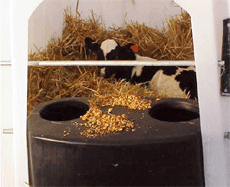



Cold Weather Calf and Replacement Heifer Comfort
Cold weather is coming. Are you prepared to provide exceptional comfort to your calves and replacement heifers this winter? Asks Kevin A. Janni, Professor and Extension Engineer, University of Minnesota, Dairy Extension.
Healthy calves and heifers grow more quickly and are able to join the milking herd at a younger age. Delaying first lactation by two or more months is an unnecessary expense that top notch dairy producers avoid.
Calf and replacement heifer comfort depends on the physical environment you provide. Young calves can thrive at cold temperatures if they have plenty of energy in their diet, clean water, fresh air, dry bedding, and a draft-free place to lie. Many of these comfort factors impact the calf’s and heifer’s ability to minimize body heat loss and manage their body temperature in cold weather.
Cold air drafts increase body heat loss from calves and heifers just like windchill factors. As heat loss increases, more energy in their diet is used to maintain body temperature and less is available for growth. In warm weather, drafts help cool animals but in cold weather, drafts chill and stress animals. Drafts can be managed by installing solid pen walls and by managing the ventilating system. Check for drafts with a bare hand. If you feel more than a slight air movement, you may have a draft.
Calves and replacement heifers need a dry place to lie. Dry organic bedding helps insulate the calf from the cold ground or floor and reduces body heat loss. Wet bedding, like wet insulation, loses its insulating value. Calves and replacement heifers that rise from lying on wet bedding will have wet hair and skin. The moisture will evaporate; and it takes energy to evaporate water. In cold weather, the energy will come from the calf. Like cold air drafts, wet bedding increases heat loss to the ground or to the air requiring more food energy for maintaining body temperature and leaving less for growth.
| Cold weather comfort indicators 1. No cold air drafts |
Calves and replacement heifers need clean dry bedding too. The moisture in urine and feces wets and soils the bedding. Calves and replacement heifers that lie on wet soiled bedding do not enjoy the insulating value of dry organic bedding. Calves with matted manure-laden hair lose the insulating value of their hair coat in cold weather. Cattle hair provides insulation by maintaining a layer of still air near the skin surface, which reduces heat loss. Calves and heifers can increase the thickness of the air layer by fluffing their hair coat. Matted manure-laden hair cannot be fluffed up to maintain the insulating still air near the calf’s skin. Wet bedding, not thoroughly dried before harvesting or wet from snow or rain, will have less moisture-holding capacity than dry bedding.
Calves and replacement heifers need a lot of clean dry fresh air from outdoors. Clean dry fresh outdoor air usually has few airborne pathogens or noxious gases. Young calves have a slowly developing immune system so it important to minimize their exposure to airborne and surface pathogens. To minimize exposure to airborne contaminants from older heifers or cows, young calves should be kept separated from them.
In mechanically ventilated barns, calves up to 2 months of age need 15 cubic feet per minute per calf of ventilation air in cold weather. Replacement heifers between 2 and 12 months of age need 20 cubic feet per minute per heifer. Based on air changes per hour, the rate for young calves and heifers is 6 air changes per hour.

The bottom line is that calf and heifer comfort is essential for vigorous growth and good health in cold weather. Well-managed hutches and pens need to be well bedded with clean dry organic bedding, have plenty of fresh air with no cold air drafts in addition to a high quality diet and plenty of clean water to provide exceptional calf and heifer comfort. Be prepared, cold weather is coming.
December 2008



